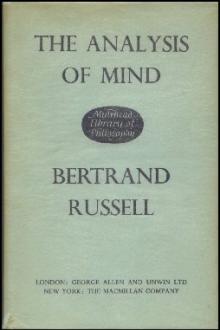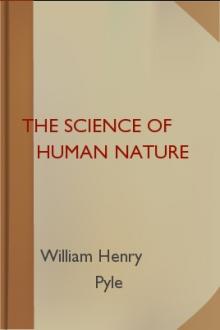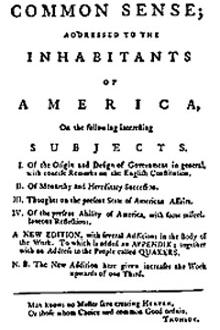How to Analyze People on Sight, Elsie Lincoln Benedict [summer beach reads txt] 📗

- Author: Elsie Lincoln Benedict
- Performer: -
Book online «How to Analyze People on Sight, Elsie Lincoln Benedict [summer beach reads txt] 📗». Author Elsie Lincoln Benedict
Interrelation of Body and Brain
¶ So today we see man a highly evolved creature who not only acts but thinks and feels. All these thoughts, feelings and emotions are interrelated.
The body and the mind of man are so closely bound together that whatever affects one affects the other. An instantaneous change of mind instantly changes the muscles of the face. A violent thought instantly brings violent bodily movements.
¶ The moving picture industry—said to be the third largest in the world—is based largely on this interrelation. This industry would become extinct if something were to happen to sever the connection between external expressions and the internal nature of men and women.
¶ How much do external characteristics tell about a man? They tell, with amazing accuracy, all the basic, fundamental principal traits of his nature. The size, shape and structure of a man's body tell more important facts about his real self—what he thinks and what he does—than the average mother ever knows about her own child.
¶ If this sounds impossible, if the seeming incongruity, multiplicity and heterogeneity of human qualities have baffled you, remember that this is exactly how the print in all books and newspapers baffled you before you learned to read.
Not long ago I was reading stories aloud to a three-year old. She wanted to "see the pictures," and when told there were none had to be shown the book.
"What funny little marks!" she cried, pointing to the print. "How do you get stories out of them?"
Printing looked to all of us at first just masses of meaningless little marks.
But after a few days at school how things did begin to clear up! It wasn't a jumble after all. There was something to it. It straightened itself out until the funny little marks became significant. Each of them had a meaning and the same meaning under all conditions. Through them your whole outlook on life became deepened and broadened—all because you learned the meaning of twenty-six little letters and their combinations!
¶ Learning to read men and women is a more delightful process than learning to read books, for every person you see is a true story, more romantic and absorbing than any ever bound in covers.
Learning to read people is also a simpler process than learning to read books because there are fewer letters in the human alphabet. Though man seems to the untrained eye a mystifying mass of "funny little marks," he is not now difficult to analyze.
Only a Few Feelings¶ This is because there are after all but a few kinds of human feelings. Some form of hunger, love, hate, fear, hope or ambition gives rise to every human emotion and every human thought.
¶ Now our actions follow our thoughts. Every thought, however transitory, causes muscular action, which leaves its trace in that part of the physical organism which is most closely allied to it.
¶ Look into the mirror the next time you are angry, happy, surprised, tired or sorrowful and note the changes wrought by your emotions in your facial muscles.
Constant repetition of the same kinds of thoughts or emotions finally makes permanent changes in that part of the body which is physiologically related to these mental processes.
¶ The jaw is a good illustration of this alliance between the mind and the body. Its muscles and bones are so closely allied to the pugnacity instinct center in the brain that the slightest thought of combat causes the jaw muscles to stiffen. Let the thought of any actual physical encounter go through your mind and your jaw bone will automatically move upward and outward.
After a lifetime of combat, whether by fists or words, the jaw sets permanently a little more upward and outward—a little more like that of the bulldog. It keeps to this combative mold, "because," says Mother Nature, the great efficiency expert, "if you are going to call on me constantly to stiffen that jaw I'll fix it so it will stay that way and save myself the trouble."
¶ Thus the more combative jaw, having become permanent in the man's organism, can be passed on to his children.
¶ Right here comes a most interesting law and one that has made possible the science of Human Analysis:
¶ The larger any part or organ the better its equipment for carrying out the work of that organ and the more does it tend to express itself. Nature IS an efficiency expert and doesn't give you an oversupply of anything without demanding that you use it.
¶ Our ancestors developed massive jaws as a result of constant combat. As fast as civilization decreased the necessity for combat Nature decreased the size of the average human jaw.
¶ But wherever you see a large protruding jaw you see an individual "armed and engined," as Kipling says, for some kind of fighting. The large jaw always goes with a combative nature, whether it is found on a man or a woman, a child, a pugilist or a minister.
¶ The large jaw, therefore, is seen to be both a result and a cause of certain things. As the inheritance of a fighting ancestor it is the result of millions of years of fighting in prehistoric times, and, like any other over-developed part or organ, it has an intense urge to express itself. This inherent urge is what makes the owner of that jaw "fight at the drop of the hat," and often have "a chip on his shoulder."
¶ Thus, because every external characteristic is the result of natural laws, and chiefly of natural selection, the vital traits of any creature can be read from his externals. Every student of biology, anatomy, anthropology, ethnology or psychology is familiar with these facts.
¶ Man's organism has developed, altered, improved and evolved "down through the slow revolving years" with one instinctive aim—successful reaction to its environment. Every part has been laboriously constructed to that sole end. Because of this its functions are marked as clearly upon it as those of a grain elevator, a steamship or a piano.
¶ Nature has no accidents, she wastes no material and everything has a purpose. If you put up a good fight to live she will usually come to your rescue and give you enough of whatever is needed to tide you over. If you don't, she says you are not fit to people the earth and lets you go without a pang. Thus she weeds out all but the strong—and evolution marches on.
¶ This inherent potentiality for altering the organism to meet the demands of the environment is especially noticeable in races and is the reason for most racial differences.
Differences in environment—climate, altitude and topography necessitated most of these physical differentiations which today enable us to know at a glance whether a man belongs to the white race, the yellow race, or the black race. The results of these differentiations and modifications will be told in the various chapters of this book.
¶ The student of Human Analysis reads the disposition and nature of every individual with ease regardless of whether that individual be an American, a Frenchman, a Kaffir or a Chinaman, because Human Analysis explains those fundamental traits which run through every race, color and nationality, according to the externals which always go with those traits.
¶ Human Analysis differs from every other system of character analysis in that it classifies man, for the first time, into five types according to his biological evolution.
¶ It deals with man in the light of the most recent scientific discoveries. It estimates each individual according to his "human" qualities rather than his "character" or so-called "moral" qualities. In other words, it takes his measure as a human being and determines from his externals his chances for success in the world of today.
¶ Every rule in this book is based on scientific data, has been proved to be accurate by investigations and surveys of all kinds of people in all parts of the world.
These rules do not work merely part of the time. They work all the time, under all conditions and apply to every individual of every race, every color, every country, every community and every family.
Through this latest human science you can learn to read people as easily as you read books—if you will take the little time and pains to learn the rules which compose your working alphabet.
¶ It is easy to know what an individual will do under most circumstances because every human being does what he wants to do in the way he prefers to do it most of the time. If you doubt it try this test: bring to mind any intimate friends, or even that husband or wife, and note how few changes they have made in their way of doing things in twenty years!
¶ Every human being is born with preferences and predilections which manifest themselves from earliest childhood to death. These inborn tendencies are never obliterated and seldom controlled to any great extent, and then only by individuals who have learned the power of the mind over the body. Inasmuch as this knowledge is possessed by only a few, most of the people of the earth are blindly following the dictates of their inborn leanings.
¶ In other words, more than ninety-nine per cent of all the people you know are following their natural bents in reacting to all their experiences—from the most trivial incidents to the most far-reaching emergencies.
¶ The individual is seldom conscious of these habitual acts of his, much less of where he got them. The nearest he comes is to say he "got it from his father" or "she takes it from grandmother." But where did grandmother get it?
¶ Science has taken the trouble to investigate and today we know not only where grandmother got it but what she did with it. She got it along with her size, shape and structure—in other words, from her type—and she did just what you and everybody else does with his type-characteristics. She acted in accordance with her type just as a canary sings like a canary instead of talking like a parrot, and just as a rose gives off rose perfume instead of violet.
This law holds throughout every species and explains man—who likes to think himself a deep mystery—as it explains every other creature.
¶ Look around you in shop, office, field or home and you will find that the quick, alert, impulsive man is acting quickly, alertly and impulsively most of the time. Nothing less than a calamity slows him down and then only temporarily; while the slow, patient, mild and passive individual is acting slowly, patiently, mildly and passively in spite of all goads. Some overwhelming passion or crisis may speed him up momentarily but as soon as it fades he reverts to his old slow habits.
¶ Human Analysis is the new science which shows you how to recognize the slow man, the quick man, the stubborn man,





Comments (0)